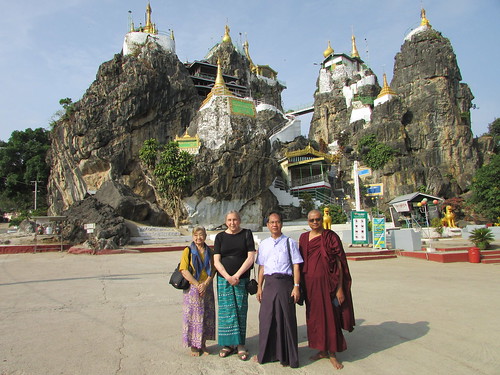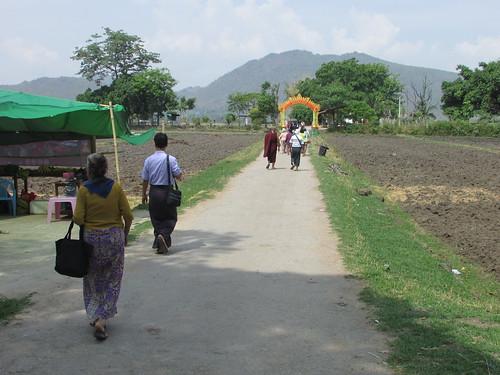Despite the title of this post, we spent Monday night and much of Tuesday in Myanmar's smallest state, Kayah, before re-entering Shan State. A good sleep at the Thingaha Hotel in Loikaw left me restored on Tuesday morning. I didn't appreciate the hotel's charming location until I met my companions for breakfast. Although within a few hundred yards of the main features of Loikaw, the hotel is situated on a quiet stretch of the northern bank of the Balu Chaung River and the open-sided pavilion on the terrace where breakfast was served overlooked the river. Both the proprietor and his wife made a point of personally welcoming me to their hotel.
I'd enjoyed a brief visit to Kayah State previously in 2017 (reports here).
After breakfast, our first visit was to Taung Gwe Zedi, the improbable group of pagodas built on a series of rock pinnacles overlooking the city. I'm afraid that, on this visit, I was content to use the elevator both to ascend and return to ground level.

Visiting Taung Gwe Zedi, Loikaw (Burma 2019).

The 'group shot' Taung Gwe Zedi
We drove south out of Loikaw, passing the display of strange white-painted Kutopoe Pillars I'd first seen two years earlier. Although Buddhism and Christianity are both widely practiced in Kayah State, I'd learned that Animism still exists and the Kutopoe Pillars form part of this tradition. There's an album of pictures of the Loikaw Kutopoe Pillars, taken in 2017, here.

Kutopoe Pillars, Loikaw (Burma 2019)
We continued on Highway 5 (which eventually leads to Taungoo, in Bago Region) for about twelve kilometres, pausing at Ngwe Taung lake and dam which supplies water for irrigation.

Ngwe Taung lake and dam, Kayah State (Burma 2019)
Two elephants were attracting a lot of interest and rides were being offered on the older elephant, in a simple 'howdah'. These were almost certainly the same pair I'd seen two years previously. After the compulsory 'group picture' we toured nearby Ngwe Taung Market. The Doctor's mother is a discerning and determined market shopper.

Our group at Ngwe Taung lake and dam, Kayah State (Burma 2019)

Shopping at Ngwe Taung Market, Kayah State (Burma 2019)
Returning to Loikaw, we checked out of the Thingaha Hotel and drove through Loikaw selecting a suitable tea shop for lunch. The Doctor is always careful in his choice of tea shops, understanding that any 'Western' digestion (not just mine) is far more easily upset by typical kitchen hygeine practices in Myanmar than a resident's would be.

Typical Kitchen of a Loikaw Teashop (Burma 2019)

View of Balu Chaung River from the Loikaw tea shop where we took lunch (Burma 2019)
After lunch, we headed out of Loikaw again to a country area south-east of Ngwe Taung where Seven Steps Lake is located. This is a series of lakes interconnected by streams and it is a favourite destination for Myanmar people. In 2017, I'd visited Seven Steps Lake in a rainstorm and that visit is described in the post here.

Seven Steps Lake
Not too far way, we reached the intriguing Umbrella lake where venting gas from geothermal activity periodically lifts the mud of a small lake into one (or sometimes more) visible domes thought to resemble umbrellas. This is another location I'd visited in 2017, described here. On that trip, I took a picture of an archway being built on the approach to Umbrella Lake. In 2019, that archway appeared to have been dismantled but an impressive, painted archway had been completed near the lake.

The approach to Umbrella Lake in 2017.

The approach to Umbrella Lake in 2019.

Our group at Umbrella Lake.
We returned to Loikaw where we visited a tourist initiative called a 'Kayan Traditional Village' - a large area of beaten earth with two rows of stalls made of bamboo and thatched. There were a number of the traditional Long-Necked Padaung women (and children) manning the various stalls, plus additional heavy, brass neck rings, carefully sliced in two and provided with tapes to allow visitors to create their own 'Long-Neck' pictures. I had visited the Padaung village of Pan-Pet in 2017 (report here), so I'll not re-iterate my distaste regarding the Long-Neck tradition which I believe is tending to die out.
Perhaps unsurprisingly, male Padaung fashion involves no heavy or permanent adaptations and our driver was happy to appear in male traditional attire.

Our driver in traditional dress at the Kayan Craft Village.
We then left Loikaw for the last time, heading north on the NH5. At the junction with the road from Phe Khong (the road we'd arrived by the previous day), we stayed on the NH5, heading north on the road which would eventually lead to Taung Gyi. We turned right off this road to reach a well-known series of waterfalls and place of pilgrimage, a beautiful spot which remained tranquil despite quite a few visitors from Myanmar.

The Waterfalls.
The various falls were interconnected by ornamental bridges, there were bathing places and inflated lorry inner tubes could be hired for young people to swim.

Burma 2019: Waterfalls showing swimming place with inflated lorry tyres.
There was also a large shrine with a huge gong outside which I was told commemorated the deaths of a large number of soldiers but I'm afraid I didn't get the details.

Burma 2019: Waterfalls, showing main shrine and huge gong.
We re-traced our route to the main road after a fascinating visit to the waterfalls and continued north, re-entering Shan State and passing through Hsihseng. After pausing at a tea shop in Loisawn for a cup of hot, sweet tea, we turned left onto the minor road which would take us to Kakku with its 2,478 Myanmar-style pagodas.
I first visited Kakku during my second visit to Myanmar in September, 2008, described here, not long after foreign tourists had been allowed to travel to what were still called 'The Long-lost pagodas of Kakku'. I thought the area very special then, as I did on my second visit in 2017 (described here), when I was able to watch a ceremony dedicating replacement 'Hti'. The 'Hti' is the delicate metal 'umbrella' which crowns the tapering spire of the pagoda. By the time we arrived at Kakku for my third visit, the sky had turned dark and the late afternoon sun produced dramatic lighting effects so that I was no less impressed than on my earlier visits.

Kakku Pagodas, Shan State.
There is one large, modern pagoda at which my friends paid their respects. Internally, there are four decorated niches with Buddha images. I was fascinated watching three work people (two men, one woman) re-gilding one of the niches.

Burma 2019: Re-gilding one of the four niches with Buddha images at the large, modern pagoda at Kakku.
I still enjoy wandering through the serried ranks of small pagodas at Kakku, with their stucco now a kaleidoscopic array of colours - various browns, white, pink - as the damage of centuries has been repaired by donors.

Burma 2019: Rows of pagodas at Kakku, Shan State.
But after a long and fairly active day, with the weather still hot compared with what I'm used to, I was tiring. We still had a drive of 46 kilometres to reach Taung Gyi, the Shan state capital, where we stayed the night. It took a little while for the Doctor to select suitable accommodation but his final choice, the Hotel Myat Nan Taw was excellent.
Related posts on this website
This is one of a series of posts describing my 14th visit to Myanmar. The post Return to Burma is the first post in the series.
Clicking on the 'Next report' link displays the post describing the next events. In this way, you may read about the trip in sequence.
Next report.
Alternately, clicking on the 'All my Burma 2019 reports' link displays all the posts on this trip in reverse date-of-posting order.
All my Burma 2019 reports.
My pictures
I've uploaded lots of pictures to 'Flickr' but they're not all sorted and titled. I'll get onto it as soon as I can.
Burma 2019
[Pictures added 17-May-2019: Edits and pictures embedded 6-Jun-2019: Further edits, pictures added 14/15-Jun-2019]
